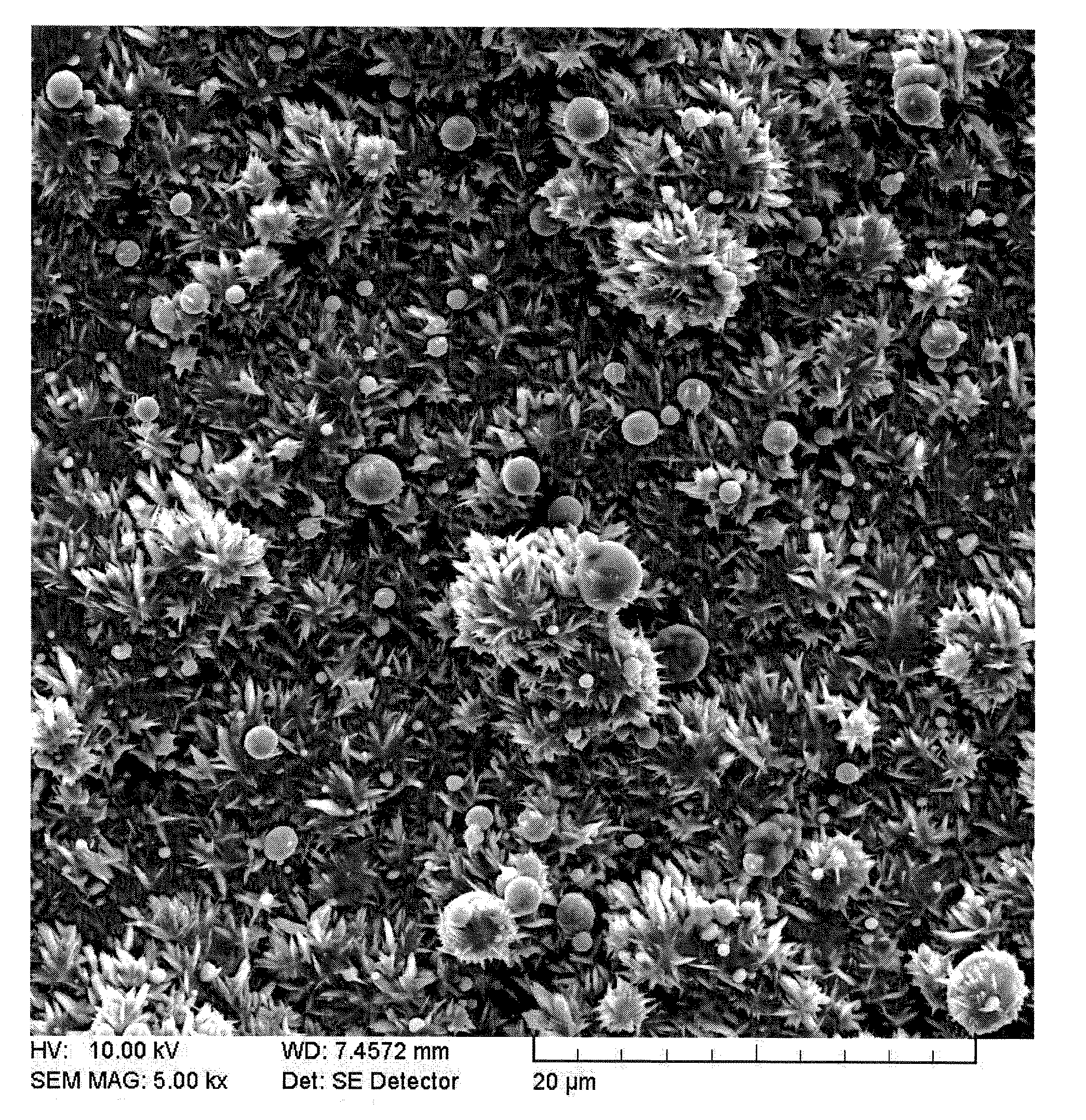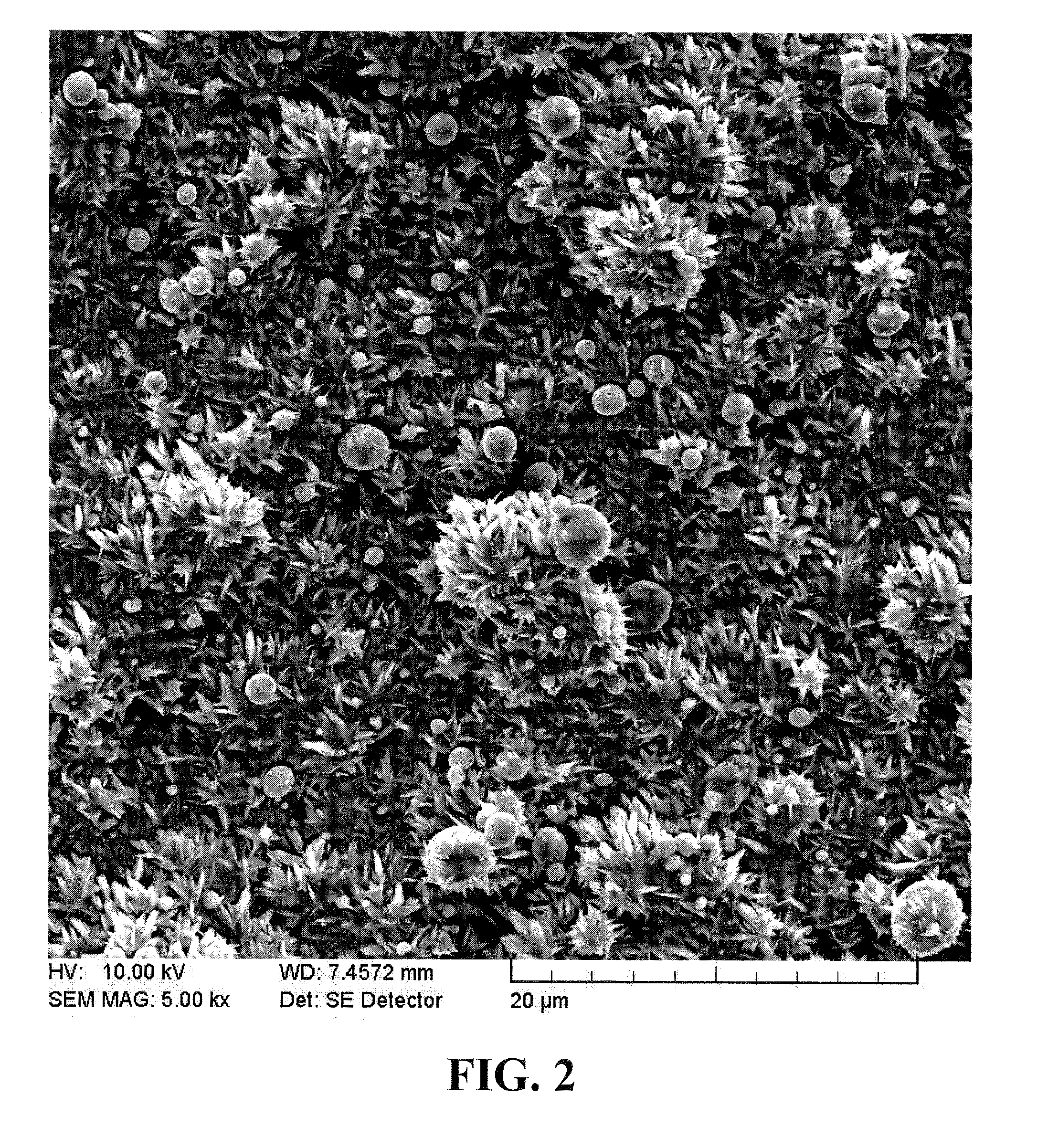Spinulose metal surfaces
- Summary
- Abstract
- Description
- Claims
- Application Information
AI Technical Summary
Benefits of technology
Problems solved by technology
Method used
Image
Examples
example 1
Spinulose Titanium or Zirconium Surfaces
[0091]Nanostructured spinulose titanium or zirconium surfaces can be produced by a modified cyclic plasma arc deposition procedure termed nanoplasma deposition (NPD). The vapor deposition apparatus for producing the metal ion plasmas can be used both for conventional metal plasma deposition and the cyclic modification used to produce spinulose surfaces and films. The apparatus is shown in FIG. 1. The metal cathode targets are disposed in a vacuum chamber. An inert gas, typically argon, is not required but may be introduced into the evacuated chamber and deposition commenced. The substrate 2 is generally positioned 6-28 inches from the target and deposition is conducted intermittently for periods of approximately 1-20 minutes. During the intervals between depositions, there is no plasma discharge and the inert gas flow optionally can be reduced or stopped completely if desired. The intervals between depositions can be varied and are about 5-90 ...
example 2
Polymer Coated Ionic Plasma Deposited (IPD) Silver / Silver Oxide
[0099]Ionic Plasma Deposition (IPD) creates a highly energized plasma from a target material, typically solid metal, from a cathodic arc discharge. An arc is struck on the metal and the high power density on the arc vaporizes and ionizes the metal, resulting in a plasma, which sustains the arc because the metal vapor itself is ionized, rather than an ambient gas.
[0100]The same apparatus used for the NPD process, FIG. 1, was used to control deposition of a silver / silver oxide plasma ejected from a silver cathodic arc target source 1 onto a substrate 2 within the vacuum chamber 4 or by a power supply 5 to the target and adjustment of arc speed 6. The closer a substrate is to the arc source, the larger and more densely packed will be the particles deposited on the substrate.
[0101]Ag / AgO was deposited onto a spinulose titanium surface coated on a titanium substrate. As shown by SEM in FIG. 8, the spinulose features of the ti...
example 3
Polymer Adhesion to Spinulose Titanium Surfaces
[0104]Interfacial adhesion of PS, PLGA, PLLA and PEG coatings to spinulose titanium and to smooth titanium surfaces were compared using a scratch induced delamination process. This test demonstrated that the polymer coatings with a range of chemical properties exhibited little, if any, delamination from the spinulose nanostructured titanium surface. The polymers were typically observed to fracture and in many cases fall off the smooth titanium surface. FIG. 9 shows the enhanced interfacial adhesion properties of PLLA to a spinulose nanostructured titanium surface following a scratch test compared to the poor adhesion properties of PLLA to the smooth titanium, FIG. 10. The work force in both scratch tests was similar.
[0105]The lack of delamination evident from observations with light microscopy showed that the interface is considerably toughened with the spinulose surface. The scanning electron microscopy (SEM) revealed a difference in f...
PUM
| Property | Measurement | Unit |
|---|---|---|
| Diameter | aaaaa | aaaaa |
| Fraction | aaaaa | aaaaa |
| Diameter | aaaaa | aaaaa |
Abstract
Description
Claims
Application Information
 Login to View More
Login to View More - R&D
- Intellectual Property
- Life Sciences
- Materials
- Tech Scout
- Unparalleled Data Quality
- Higher Quality Content
- 60% Fewer Hallucinations
Browse by: Latest US Patents, China's latest patents, Technical Efficacy Thesaurus, Application Domain, Technology Topic, Popular Technical Reports.
© 2025 PatSnap. All rights reserved.Legal|Privacy policy|Modern Slavery Act Transparency Statement|Sitemap|About US| Contact US: help@patsnap.com



